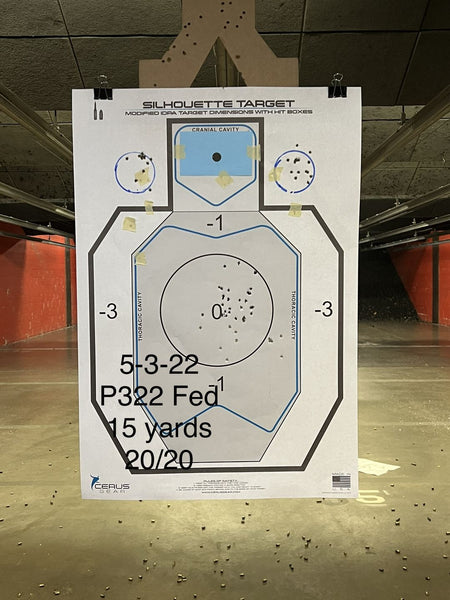When it comes to shooting targets, many shooters assume that steel targets are the best option due to their durability and the satisfying sound they make when hit. However, paper targets have their advantages that are worth considering. In this article, we'll explore the differences between paper and steel targets, highlighting the strengths and weaknesses of each, and helping you decide which is best for your training needs.
Paper Targets: Affordable and Practical for Beginners
For those just starting in shooting, paper targets provide an excellent balance of affordability and practicality. Their low cost and simplicity make them an ideal choice for beginners looking to improve their accuracy without breaking the bank.

Cost-Effectiveness for New Shooters
Paper targets are significantly cheaper than steel targets, making them an ideal choice for beginners or shooters looking for an affordable option for regular practice. Additionally, they are lightweight and easy to transport, making them convenient for shooting in different locations.
Clear Feedback for Improving Accuracy
One of the biggest advantages of paper targets is the clear feedback they provide. Shooters can instantly see where their shots hit, allowing them to make adjustments in real time. This level of visibility is harder to achieve with steel targets, especially at a distance.
Customization and Variety Keep Training Fun
Lastly, paper shooting targets offer a wider range of options when it comes to customization. From silhouette targets to poker games and shooter correction, paper targets can add a fun and challenging element to your shooting practice. Using different styles of paper targets can also help you keep your shooting sessions more interesting and fun!
Beyond cost and variety, paper targets also make it easier to store your gear at home. You can stack dozens of targets in a single folder without taking up much space. Many shooters also pair paper targets with shot analysis tools or mobile apps that scan and score your hits, making it easier to track progress over time.
Steel Targets: Durability and Immediate Feedback
Steel targets offer unmatched durability and instant auditory feedback. While they may come with a higher price tag, their longevity and immediate confirmation of successful hits make them a top choice for more experienced shooters.
Built to Last
Steel targets are extremely durable and can withstand repeated impacts without needing frequent maintenance. While they require a higher initial investment, their longevity and resistance to wear make them an attractive option for regular shooters looking for a long-term solution.
Instant Audible Feedback
One of the main advantages of steel targets is the immediate audible feedback. The metallic sound when a shot hits provides instant confirmation of a successful shot, which can be a motivator for many shooters, particularly in competitive settings.
Pros and Cons of Paper Targets
Pros of Paper Targets
-
Low Cost: One of the key benefits of paper targets is their affordability, allowing shooters to buy multiple targets for a low price.
-
Portability: Paper targets are light and easy to transport, ideal for shooters who practice at various locations.
-
Customization: Paper targets come in a wide range of designs, from silhouette targets to games, adding a fun and engaging element to shooting practice.
Cons of Paper Targets
-
Limited Durability: Paper targets are more susceptible to wear and tear and can tear after multiple impacts, especially with high-velocity rounds.
-
Single-Use: While reusable with target pasters or patches, paper targets are generally not as durable as steel targets.
Pros and Cons of Steel Targets
Pros of Steel Targets
-
Long-lasting: Steel targets are more durable and resistant to wear. They can handle multiple impacts without losing effectiveness.
-
Real-Time Feedback: The immediate sound produced when a steel target is hit makes it easy for shooters to confirm their shots instantly.
Cons of Steel Targets
-
Higher Cost: The upfront cost of steel targets can be significantly higher compared to paper targets.
-
Weight and Portability: Steel targets are heavier and harder to transport, which may be inconvenient for shooters who need portability.
-
No Visual Impact Feedback: Unlike paper targets, steel targets do not provide clear visual feedback of where each shot hit, which can make it harder to track your accuracy.
Paper Targets vs. Steel: Which is Best for Your Shooting Style?
Choosing the right target depends on your shooting style and goals. Whether you’re a beginner aiming for clear feedback or an experienced shooter looking for long-lasting performance, understanding the strengths of both paper and steel targets will help you make the best decision for your practice sessions.
Best for Beginners: Paper Targets
For beginners, paper targets are a great choice. They provide immediate visual feedback, which is essential for learning and improving shot placement. Additionally, their lower cost makes it easy to practice frequently without a major investment.
Best for Experienced Shooters: Steel Targets
For more experienced shooters, steel targets are often preferred because of their durability and the instant auditory feedback they provide. However, they don't offer the same level of visual feedback that paper targets do, which could be a downside for training aimed at improving accuracy.
Conclusion: Making the Right Choice for Your Training Needs
When choosing between paper and steel targets, it's important to consider your individual training needs. If you're looking for an affordable option that provides clear visual feedback, paper targets are an excellent choice. However, if you want durability and immediate feedback in your training sessions, steel targets might be the better option. Both have their strengths and weaknesses, and the right choice depends on factors such as experience, training frequency, and budget.
Frequently Asked Questions
Can paper targets be used for long-range shooting?
Absolutely. As long as you can see or scope the target, paper works well at a distance, and you can mark hits for future reference.
Do paper targets require special stands?
Not necessarily. Most paper targets work with simple wooden, cardboard, or portable frames, making them easy to set up anywhere.
Are paper targets reusable?
Although they are designed for one-time use, you can extend their life by using shoot-and-see stickers or patches to cover old holes.
Is there a hybrid approach that makes sense?
Absolutely. Many shooters start drills on paper to check accuracy, then transition to steel for speed and feedback. You don’t need to pick one forever.






